If you want to grow your business with cold outreach, email sequence is your pivotal tool for success.
This set of often automated, prospecting emails aims to nurture your leads’ interest in your product or service.
But how do you craft a perfect prospecting email sequence? Which timeframe and steps to use to build relationships and drive conversions in 2025?
This guide will give you insights into prospecting email sequence definition, best practices, and actionable tips on how to create one in 2025.
What is an email sequence
A prospecting email sequence, often referred to as a “cold email sequence”, is a series of pre-written emails sent to leads who haven’t previously engaged with the sender.
The primary goal of email sequence is to initiate a conversation, build a relationship, and eventually convert these prospects into paying customers.
When executed well, a prospecting email sequence can be a powerful tool to expand your client base and drive sales.
However, it’s essential to approach it with respect for the recipient’s time and attention.
Over-aggressive or poorly crafted sequences can lead to negative perceptions of your product/service and potentially result in your emails being marked as spam.
5 reasons why you shouldn’t stop your cold email at one email
Stopping your cold email outreach at just one email is generally not recommended for several reasons:
- Memory Refresh: Your prospect might have seen and even appreciated your first email but forgot to reply due to various reasons. A follow-up acts as a reminder.
- Show Commitment: Persistence, when done right, demonstrates commitment and genuine interest. It shows the prospect that you value the potential relationship or business opportunity.
- Provide More Information: Follow-up emails provide you with the opportunity to share additional information, address common objections, or clarify any misunderstandings that might arise from the initial email.
- Increased Engagement: lemlist’ statistics show that sending multiple follow-up emails can lead to a significant increase in response rates compared to sending just one email.
- Build Awareness: Even if the recipient doesn’t respond, multiple touchpoints increase brand awareness. The next time they come across your company or service, they might be more receptive.
How long should an email sequence be
How many follow-up emails is appropriate?
In cold sales outreach, you should be sending anywhere from 4-9 follow-up emails.
According to our analysis of millions of cold emails, your overall reply rates increase with every follow-up. But after 9 or more follow-ups, the benefits are negligible, and you could be marked as spam.
If you send one email, you’re looking at an average reply rate of just 4.5%. But if you go up to 10, your total reply rate gets as high as 22.37%.
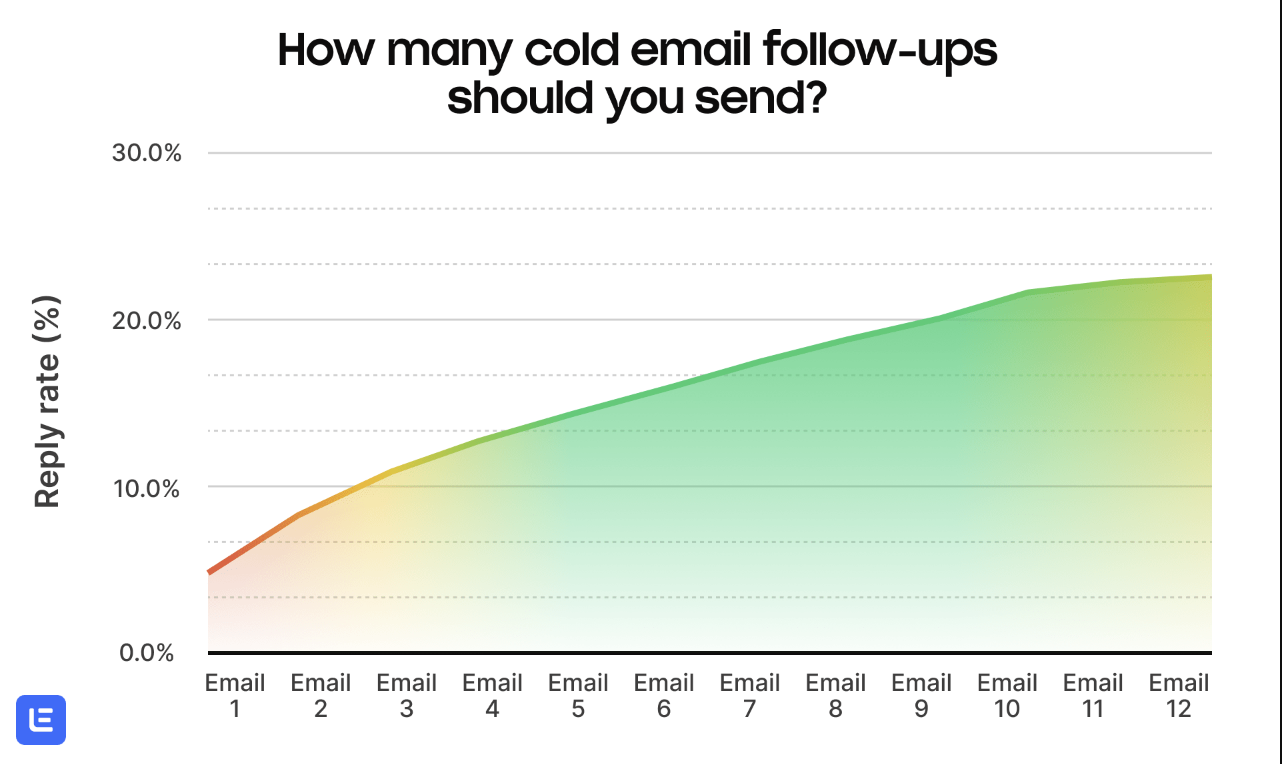
Let’s break it down into more concrete numbers.
Say you send a cold email campaign to 300 prospects. If you stop after the first point of contact, with an average reply rate of 4.5%, you might get about 14 replies.
But if you continue, you can get an average of 4-10 replies per follow-up, leading to a total of 60+ replies at the end of the campaign.
So don’t give up after the first or second email. Many prospects just need a reminder or an extra detail or two before they’re ready to reply.
Now that you know how many follow-ups to send, let’s get into how and when you should send them.
How long should you wait between follow-up emails?
Leave at least 2 days between your first and second point of contact, then give your leads a bit more time in between emails as you continue to follow up.
Here’s the frequency we recommend:
- 2-day delay between emails 1 and 2
- 4-day delay between emails 2 and 3
- 4-day delay between emails 3 and 4
- 5+ days between follow-ups after the 4th email
Depending on how many messages are in your sequence, aim for a total duration of 10-25 days.
The key here is to be persistent, but polite. If they’re not responding to your first email after 2 days, don’t expect them to respond faster after your 3rd or 4th.
And, of course, if they respond saying that they are not interested, do not continue to follow up.
P.S. To get more data-driven insights with tips on how to write effective follow-up emails, check out this ultimate follow-up guide!
What are the types of email sequence
Email sequences can be crafted for various purposes, and the type of sequence you deploy will often depend on your specific objectives and where your audience is in the customer journey.
Here are some of the most common types of email sequences:
Cold Outreach Sequence
→ Purpose: Engage potential leads or partners who haven’t had prior interaction with your brand.
→ Components: Introduction, value proposition, follow-ups, and possibly a concluding email.
Welcome Sequence
→ Purpose: Nurture and onboard new subscribers or customers.
→ Components: Thank you for subscribing/buying, introduction to the brand, setting expectations, and showcasing key resources or offers.
Engagement Sequence
→ Purpose: Engage subscribers who haven’t taken a desired action, like making a purchase.
→ Components: Highlighting benefits, sharing testimonials, special offers, and product features.
Post-Purchase Sequence
→ Purpose: Enhance the experience of customers after they’ve made a purchase.
→ Components: Thank you for purchasing, how to use the product, upselling/cross-selling other products, and requesting reviews or feedback.
Re-engagement (or Win-back) Sequence
→ Purpose: Re-engage subscribers or customers who’ve become inactive.
→ Components: Checking in, special offers or discounts to entice them back, and possibly an option to opt out or specify email preferences.
Abandoned Cart Sequence
→ Purpose: Encourage customers to complete their purchase after leaving items in their cart.
→ Components: Reminder about the abandoned cart, benefits of the product left behind, potential discounts or incentives, and addressing common objections or concerns.
Educational (or Drip) Sequence
→ Purpose: Educate subscribers about a specific topic over a series of emails.
→ Components: Introduction to the topic, breakdown of sub-topics across emails, actionable steps or tips, and concluding with a call to action related to the topic.
Upsell/Cross-Sell Sequence
→ Purpose: Promote additional products or higher-tier offers to existing customers.
→ Components: Introduction to the new product/offer, benefits over the current product, testimonials or case studies, and special offers.
Feedback or Review Sequence
→ Purpose: Gather feedback or encourage reviews from customers.
→ Components: Request for feedback/review, benefits of providing feedback, possible incentives for reviewing, and thanking them for their input.
Affiliate or Partner Sequence
→ Purpose: Engage and educate partners or affiliates about promoting your product.
→ Components: Benefits of the partnership, educational content about the product, promotional strategies, and performance incentives.
Milestone or Celebration Sequence
→ Purpose: Celebrate milestones like anniversaries, birthdays, or other significant events with subscribers or customers.
→ Components: Wishes, showcasing the journey or progress, special offers or giveaways, and a thank you for being part of the journey.
These are broad categories, and the specific content, structure, and duration of each sequence can vary based on industry, audience, and individual business objectives.
No matter the type, ensure that every email provides value and is tailored to its intended audience!
What makes a successful email sequence: The ultimate checklist
1. Research & Planning
[ ] Identify your ICP: Clearly define who you’re reaching out to. Gather details about their company, role, challenges, and other relevant details.
[ ] Goal Definition: Understand the primary objective of your email sequence (e.g., schedule a demo, get a reply, promote content).
2. Email Content & Design
[ ] Engaging Subject Lines: Craft subject lines that encourage recipients to open the email.
[ ] Personalization: Tailor content to each recipient’s specific needs or challenges.
[ ] Clear Value Proposition: Clearly explain the benefit of your offering.
[ ] Crisp and Concise Content: Keep email length short and to the point.
[ ] Strong Call to Action (CTA): Direct recipients toward a specific next step.
[ ] Visual Elements: Consider including relevant and engaging images or infographics.
[ ] Professional Tone: Ensure a respectful and professional tone throughout.
[ ] Error-Free Content: Proofread for grammar, punctuation, and spelling mistakes.
3. Sequence Structure
[ ] Introduction Email: Start with a catchy introduction and main value proposition.
[ ] Follow-Up Emails: Schedule follow-ups, each offering additional value or addressing potential objections.
[ ] Closing Email: Conclude with a final touchpoint, summarizing the value proposition and providing the last chance CTA.
4. Timing & Scheduling
[ ] Optimal Send Times: Determine the best days/times for your target audience.
[ ] Spacing: Ensure emails are spaced appropriately (typically several days apart).
5. Tracking & Analysis
[ ] Analytics Integration: Ensure tracking is set up to measure open rates, click-through rates, replies, etc.
[ ] A/B Testing: Consider testing different subject lines, CTAs, or content to determine what’s most effective.
[ ] Feedback Collection: Allow for feedback from recipients to refine future campaigns.
6. Compliance & Best Practices
[ ] Opt-Out Mechanism: Include a clear way for recipients to unsubscribe.
[ ] Legal Compliance: Ensure your emails comply with laws like the CAN-SPAM Act, GDPR, or other relevant regulations.
[ ] Avoid Spam Triggers: Ensure your content (such as spam words), format, and sending practices don’t trigger spam filters.
7. Review & Feedback (optional)
[ ] Peer Review: Have a colleague or team member review the sequence for feedback.
[ ] Test Sends: Send test emails to ensure proper formatting and to check links/CTAs.
8. Continuous Improvement
[ ] Regularly Update Content: Keep your content fresh and up-to-date.
[ ] Adapt Based on Metrics: If certain emails aren’t performing well, adjust your approach.
[ ] Gather Insights: Solicit feedback and learn from each campaign to refine future sequences.
Following this checklist will provide a comprehensive approach to designing and deploying a successful cold email sequence. However, always remember to be genuine and prioritize providing value to your recipients!
How to add value with each step of your sequence
Adding value at every step of your email sequence ensures that recipients remain engaged and find it beneficial to continue reading your emails, and eventually – respond.
Here’s how you can add value at each step:
Introduction email
→ Personalization: Address the recipient by their name and reference specifics about them or their business.
→ Immediate Value Proposition: Clearly state the benefit they’ll gain from your product, service, or content.
→ Resource Sharing: Provide a valuable piece of content or tool upfront (e.g., a free guide, a helpful infographic, or a relevant blog post).
Follow-Up Emails
→ Answer Common Questions: Address typical questions or misconceptions about your offering.
→ Share Testimonials: Offer social proof by sharing success stories or positive feedback from other clients or users.
→ Provide Educational Content: Offer insights, tips, and best practices related to your product or industry.
→ Exclusive Offers: If applicable, provide a special discount or bonus specifically for your email recipients.
Engagement Emails
→ Interactive Content: Use polls, surveys, or quizzes to engage and gather feedback.
→ Behind-the-Scenes Look: Showcase the human side of your business. Share company updates, team introductions, or how your product is made.
→ Curated Content: Share a round-up of industry news, trends, or valuable content from other sources.
Post-Purchase or Onboarding Emails
→ Step-by-Step Guides: Provide clear instructions on how to get started or maximize the use of a purchased product or service.
→ Access to Support: Highlight ways they can get help, such as FAQs, customer service contact information, or tutorial videos.
→ Community Building: Introduce them to user communities, forums, or social media groups where they can engage with other users.
Re-engagement or Win-back Emails
→ Feedback Solicitation: Ask for their input on why they’ve been inactive and what they’d like to see improved.
→ Special Incentives: Offer exclusive discounts or early access to new products/features.
→ Highlight Updates: Inform them about product updates, company milestones, or changes that might interest them.
Abandoned Cart Emails
→ Product Benefits: Reiterate the benefits or unique selling points of the products left in the cart.
→ Time-Limited Offers: Create urgency with a limited-time discount or bonus.
→ Comparison: Showcase how your product stands out compared to competitors.
Educational or Drip Sequence
→ Deep Dives: Delve into the specifics of a topic, offering actionable advice and unique insights.
→ Multimedia Content: Use videos, webinars, podcasts, or infographics to explain concepts in a more engaging way.
→ Interactive Learning: Offer quizzes, assignments, or challenges to reinforce learning.
Upsell/Cross-Sell and Feedback Emails
→ Customized Recommendations: Based on their purchase history or behavior, suggest other relevant products or services.
→ Show Appreciation: Thank your customers for their loyalty and feedback, possibly rewarding them with loyalty points or exclusive deals.
Milestone or Celebration Emails
→ Gratitude: Express your appreciation for their loyalty.
→ Reflect on the Journey: Share memorable moments, growth stories, or key milestones.
→ Special Celebratory Offers: Provide exclusive deals or giveaways to celebrate together.
Remember, the key to adding value is understanding your audience’s needs and preferences!
Continually gather feedback, analyze email performance metrics, and adjust your content to ensure you’re meeting those needs and delivering genuine value.
An example of a prospecting email sequence to get 17-30% reply rates
Here’s the cold outreach sequence we used to get 17-30% reply rates.
To ensure you boost your reply chances, we encourage you to go multichannel and use multiple communication channels to meet your leads on their preferred platform.
This will increase engagement and expand your visibility.
Step 1: Email
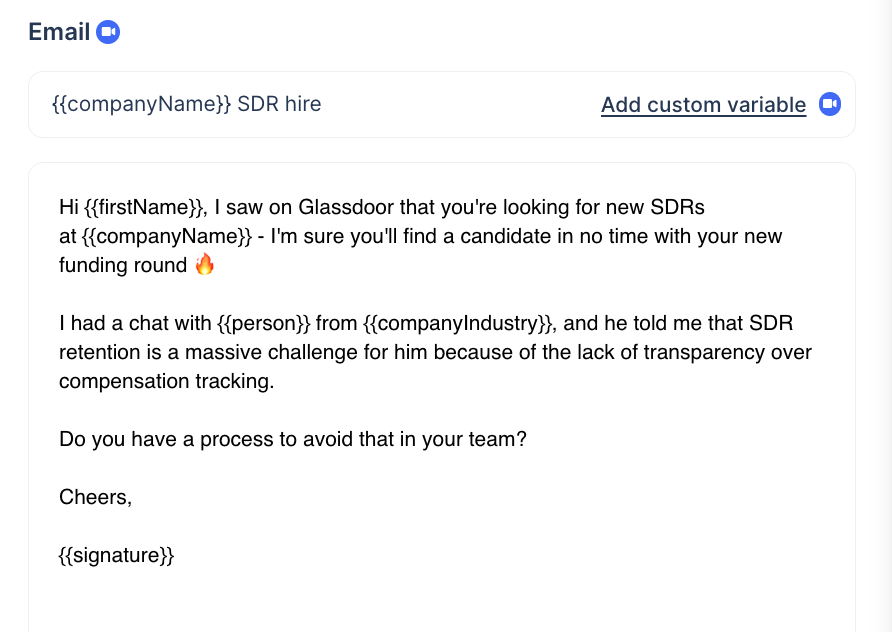
→ The subject line is short, personalized, peaks curiosity, doesn’t look like a marketing email, and it’s straightforward
→ The intro line mentions relevant triggers for reaching out, which. motivates leads to read the rest of the email
→ There is a relevant source of information that matches your leads industry or desired outcomes
→ The CTA doesn’t ask immediately for a meeting but rather confirms the interest
wait 2 days
Step 2: Visit LinkedIn profile
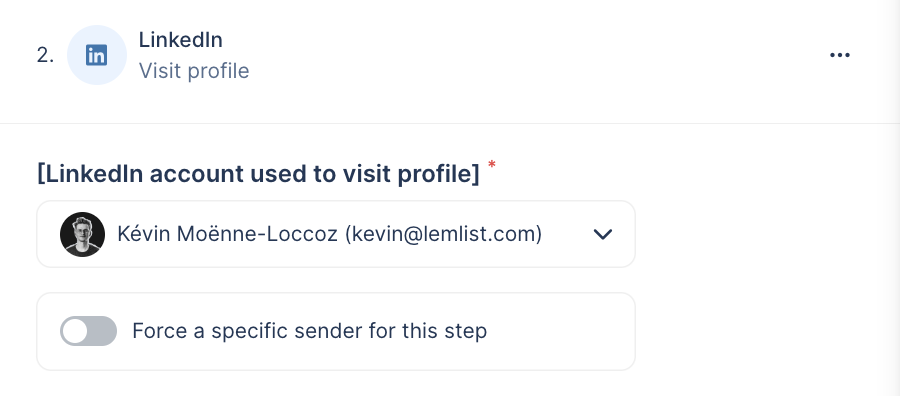
→ This step will help you stay on your leads’ minds and sound more familiar the next time you reach out to them. It will put a picture to your name and remind them to reply to your initial email.
wait 2 days (since your previous step didn’t require a response or too much effort from your leads, you can keep this timeframe short)
Step 3: Send LinkedIn connection request
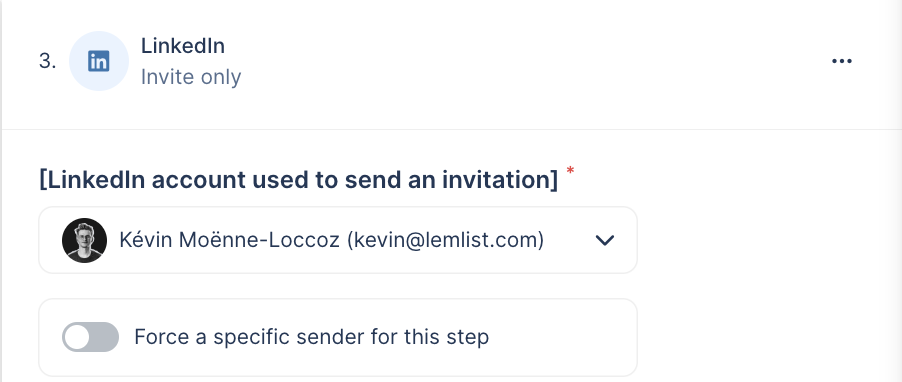
→ It’s unnecessary to include the message as you want your profile to speak for itself (except if it’s ultra-personalized and brings additional value)
→ Especially avoid generic messages that will only push away your leads from accepting your request
Step 4: Email
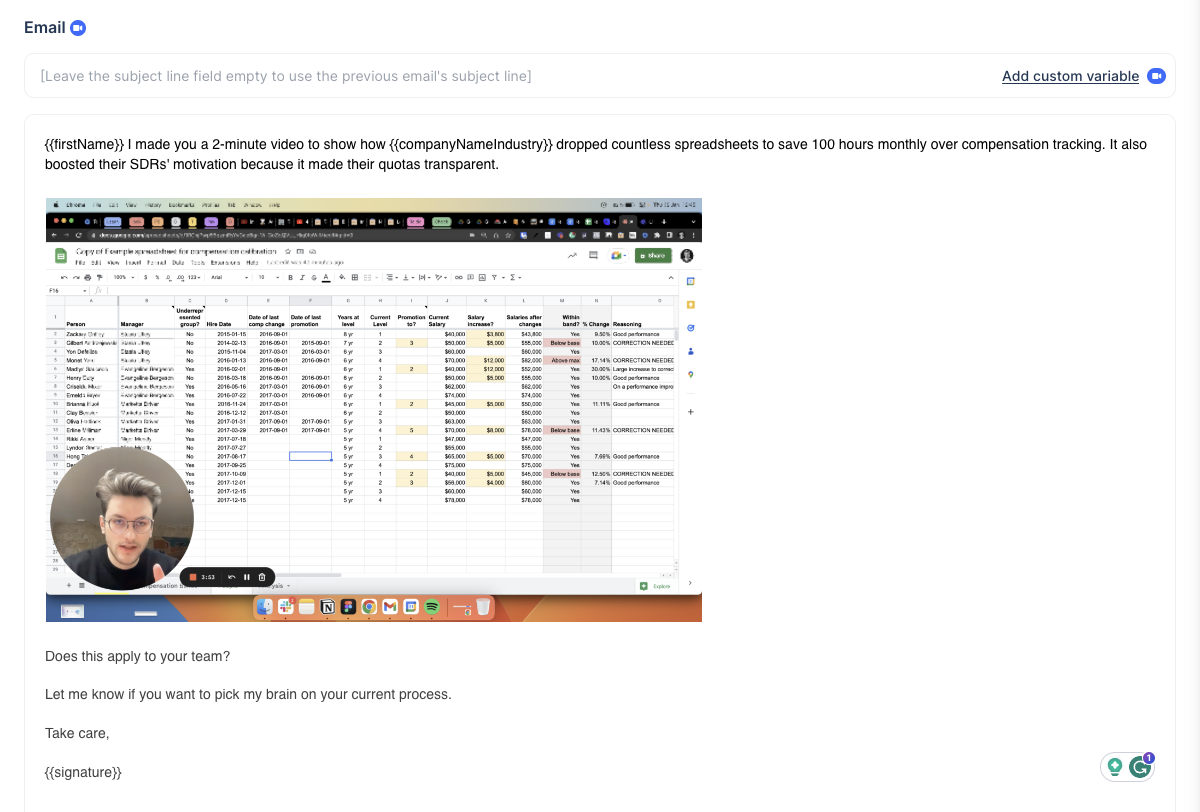
→ There is a personalized video that clearly states specific outcome and steps on how to achieve it
→ The video thumbnail image is the first thing your prospect will see and therefore makes your email stand out from tons of others in your leads’ inboxes
→ The intro line that mentions a desired income piques leads’ interest in finding out how to achieve the same
→ CTA is a conversation opener as it requires a response to the email
wait 3 days
Step 5 – 9: Visit LinkedIn profile from multiple LinkedIn accounts
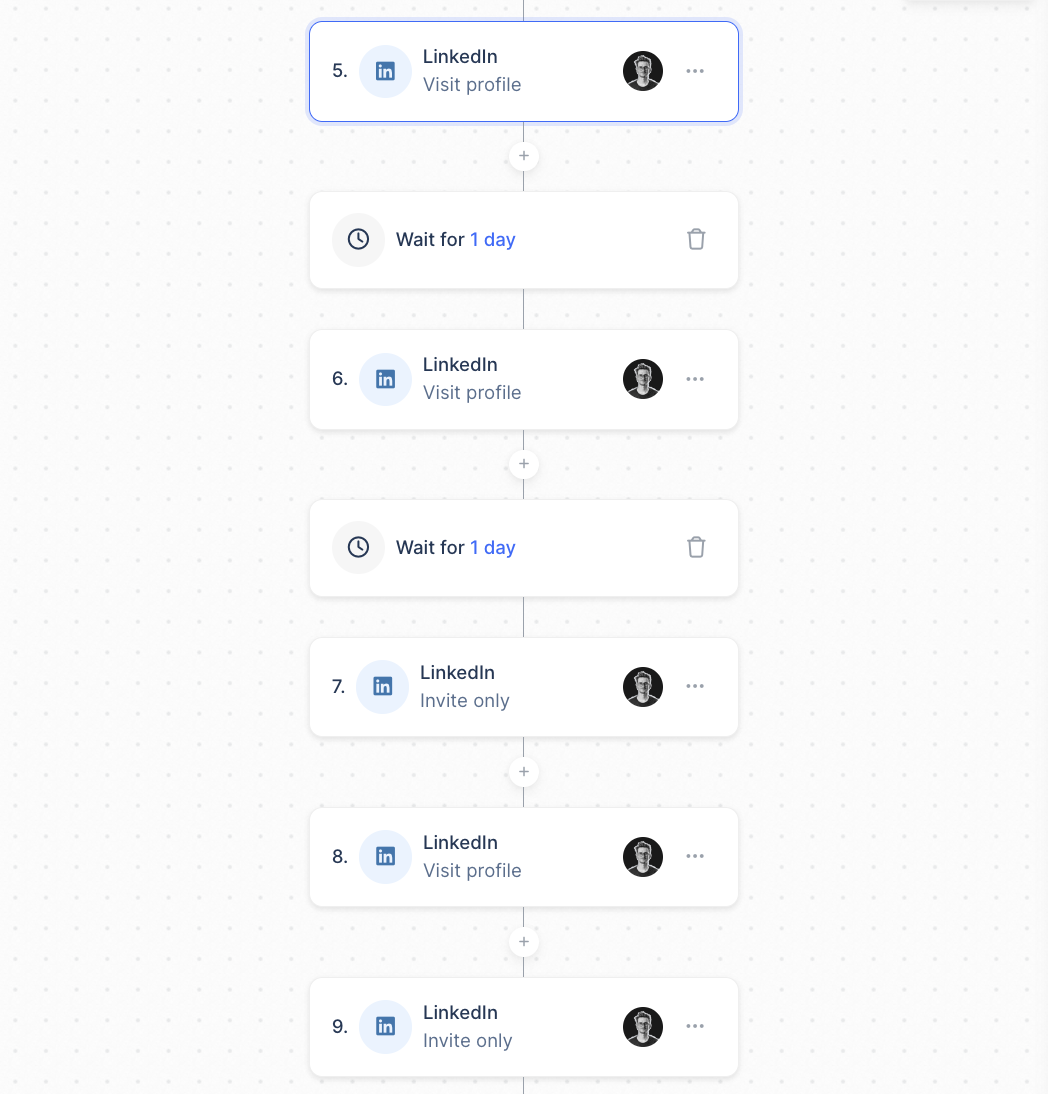
→ You can use LinkedIn profiles from multiple colleagues who have positioned themselves as industry experts (relevant to your lead) to visit your leads’ profiles.
This increases the chance of your leads seeing your brand. If your leads accept any of your multiple LinkedIn requests, they will start seeing your posts which increases personal and company credibility, and the likelihood of replying to your cold outreach sequence.
wait 2 days
Step 10: Email
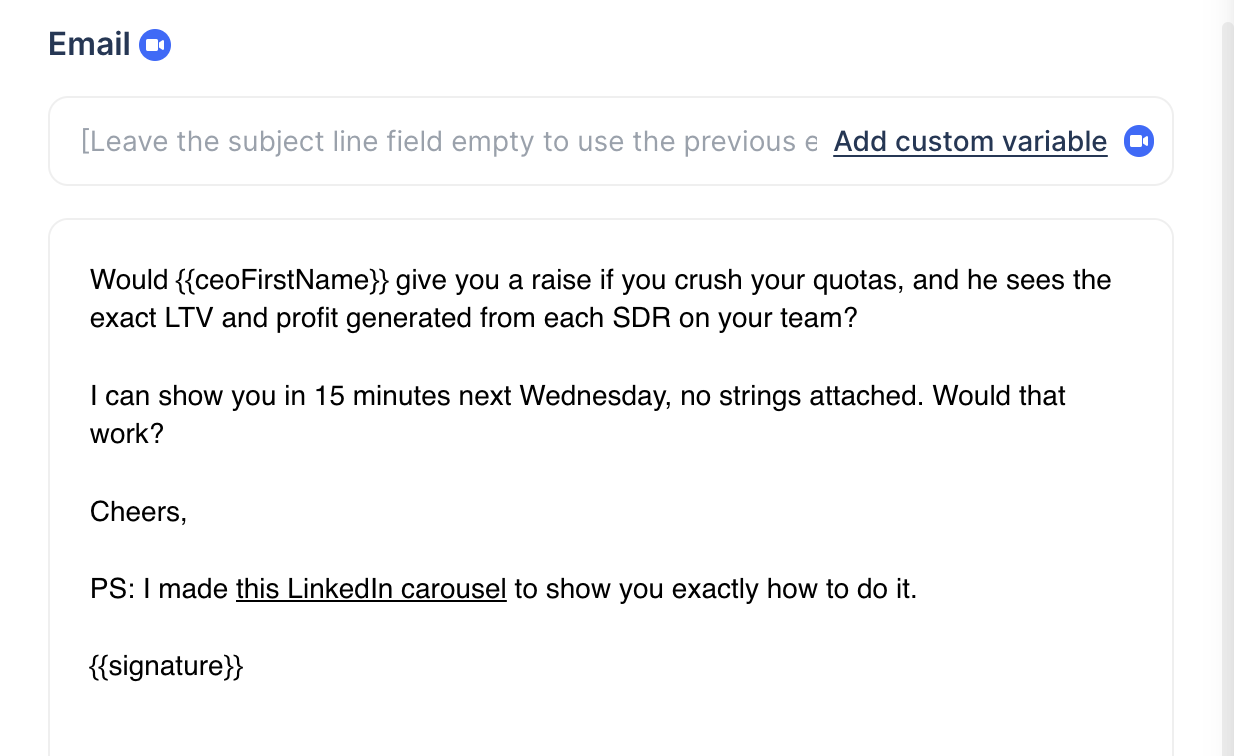
→ There is a first name of the target’s direct manager that catches the leads’ attention
→ Ask for a call is very precise and doesn’t require too much effort from leads
→ There is additional value in the PS section that solves the leads’ specific challenge. This will strengthen your position as an expert and push leads to take action
wait 3 days
Step 11: LinkedIn voice message
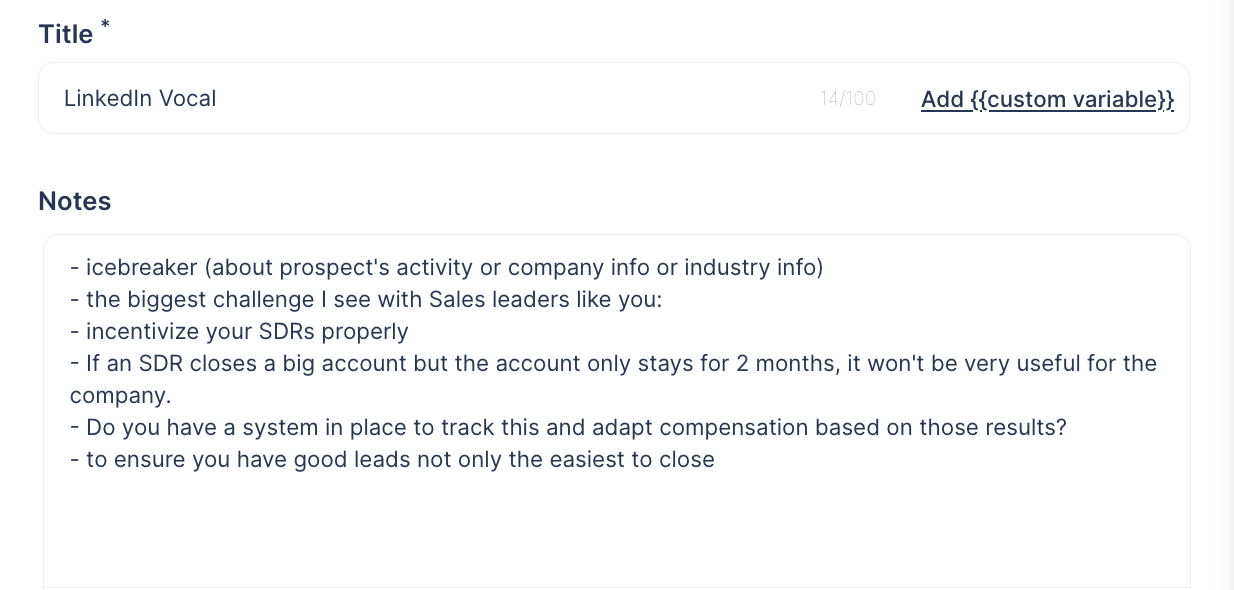
→ Sending LinkedIn vocals will make you stand out, as your leads probably don’t receive one every day! It will boost their interest and push engagement as they have to press play to hear what it’s about.
wait 5 days
Step 12: LinkedIn message
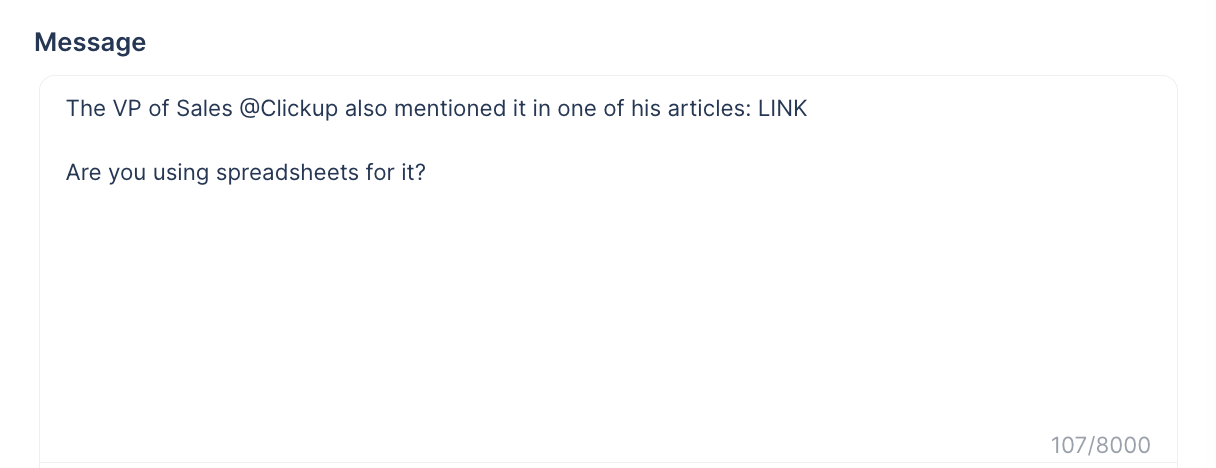
→ Instead of asking leads if they listened to your voice message, add even more value!
Add more social proof to back up everything you said so far and boost credibility.
wait 3 days
Step 13: LinkedIn message
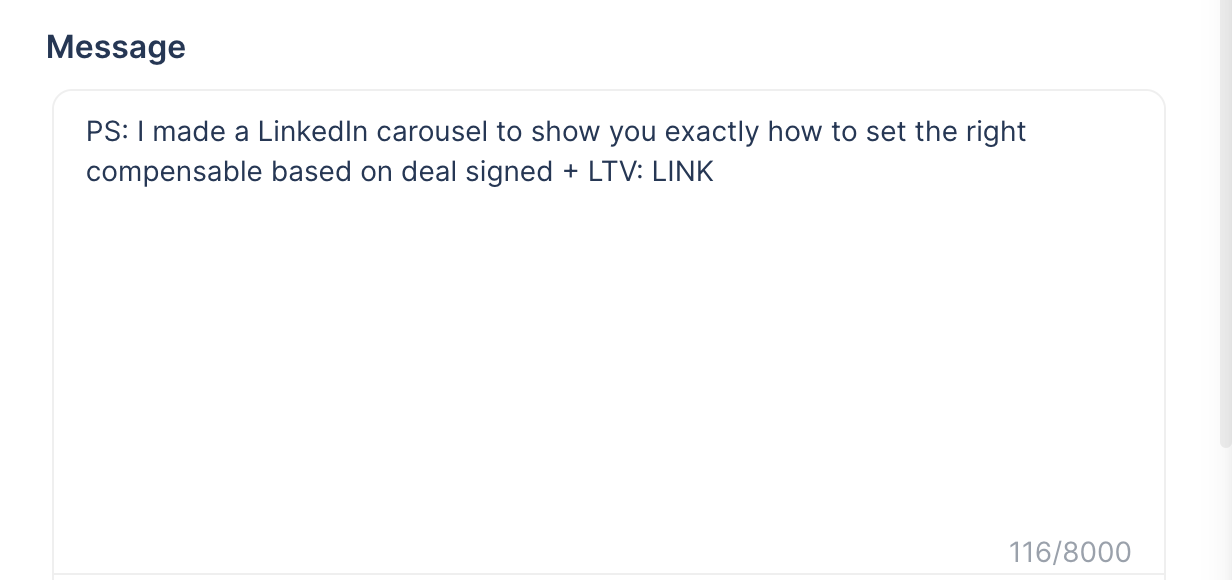
→ In this step, add even more value – give even more insights from a different angle on how to perform the outcome
→ Because it’s a PS element, it seems like an addition to the previous message and not just spammy content
wait 3 days
Step 14: Email
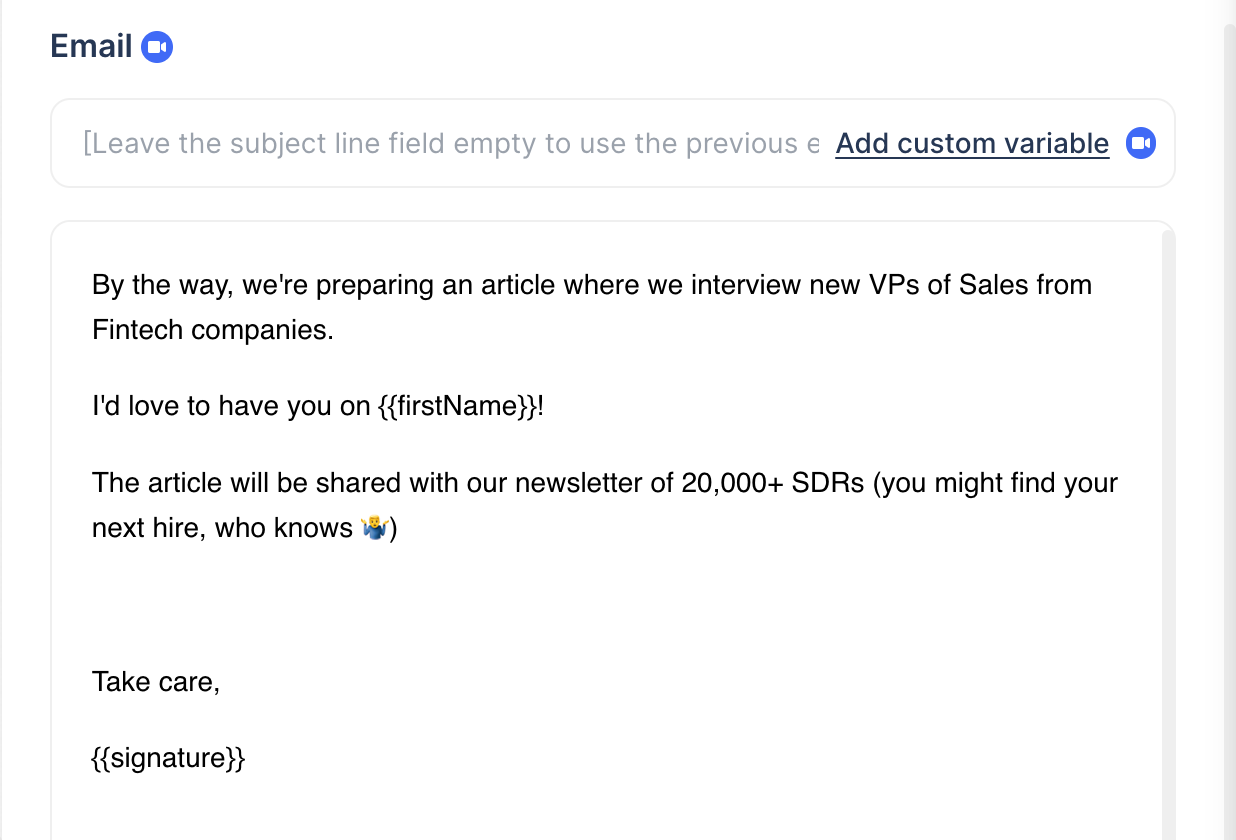
→ This final email is also known as a “breakup” email where you can use either:
- humor approach and put funny gif
- ask if there is someone else in the company dealing with this specific challenge interested in solving it
→ It’s focused on creating a really good resource for a specific topic, needing leads’ opinions, and making them feel important
→ There is very niche social proof that encourages leads to take action
Bonus: How to create a fully personalized prospecting email sequence in seconds
Creating an effective cold email can be a struggle, as most people don’t know what to write in their emails, how to catch a prospect’s attention, or personalize their approach..
With the help of artificial intelligence (AI), you can create personalized outreach sequences that drive engagement and conversions!

Here’s how to do it in lemlist:
[ ] Open up the lemlist app (if you don’t already have an account, you can sign up to lemlist for free
[ ] Create a new campaign (or choose a campaign you’ve already created)
[ ] Choose to create your sequence with the help of AI
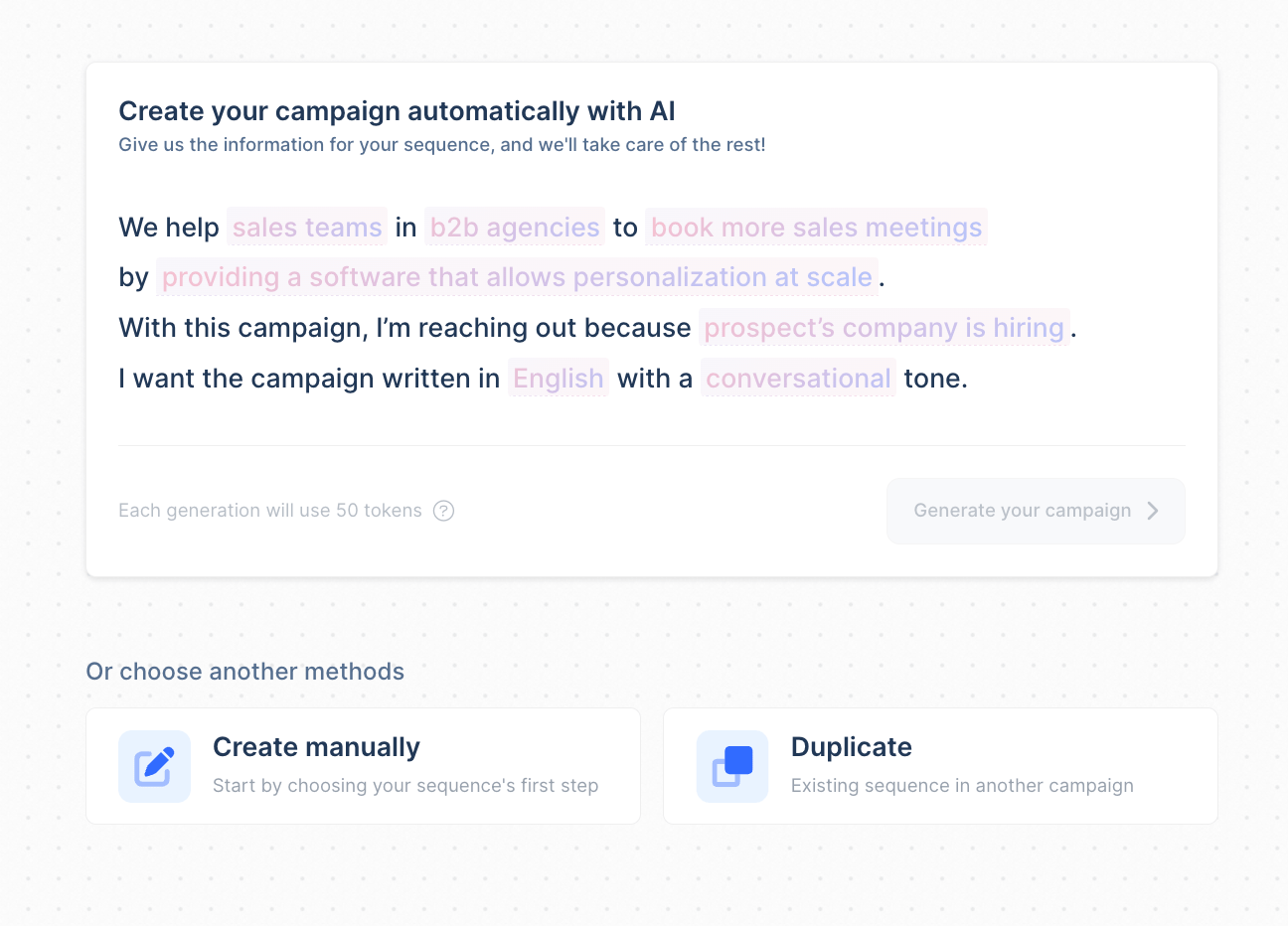
[ ] Fill in your:
- target audience
- value proposition
- trigger
- language
- tone of voice
Here’s what that looks like
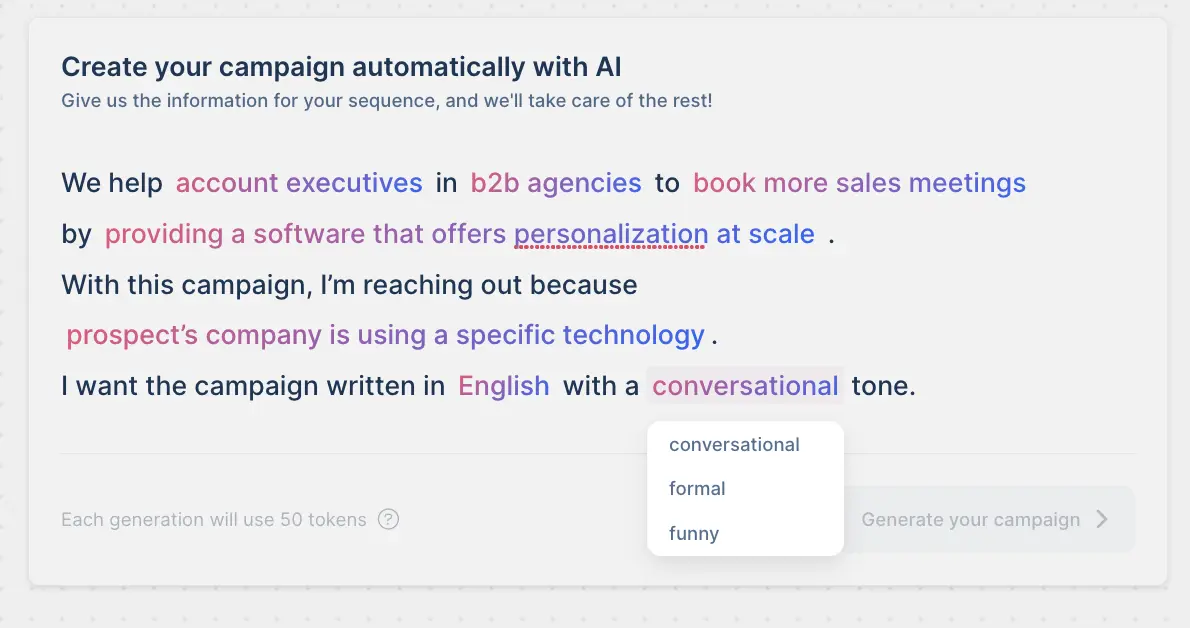
[ ] Click “generate your campaign” and let AI create your fully personalized outreach sequence!
For the best outreach results, you can tweak your AI-generated campaign by following this 10-rules checklist:
- Your CTA is less than 7 words
- You address the prospects’ pain points
- You use line breaks after every sentence
- Your cold emails contain 50 to 100 words
- There’s an apparent reason why you got in touch
- Your subject lines are all lowercase, and up to 2 words
- You use the simple language that 10 year old understands
- You show what impact an action will have on your prospect’s key metric
- There aren’t “fluff” sentences such as “Hope you’re well” that don’t bring value
- There are enough days between each follow-up to give your leads time to answer
P.S. You can take your personalization step further with lemlist custom variables to show your prospects you’re willing to go the extra mile & boost your reply chances!
Conclusion
Creating the right prospecting email sequence requires time, effort, and a deep understanding of your prospects.
But with the right approach and tools, you can create powerful email sequences that not only engage your prospects but also convert them into loyal customers.
So, why wait?
Start leveraging the power of email sequencing today and watch your business grow!
Your source of actionable outreach tips and strategies that will help you get replies and grow your business.


